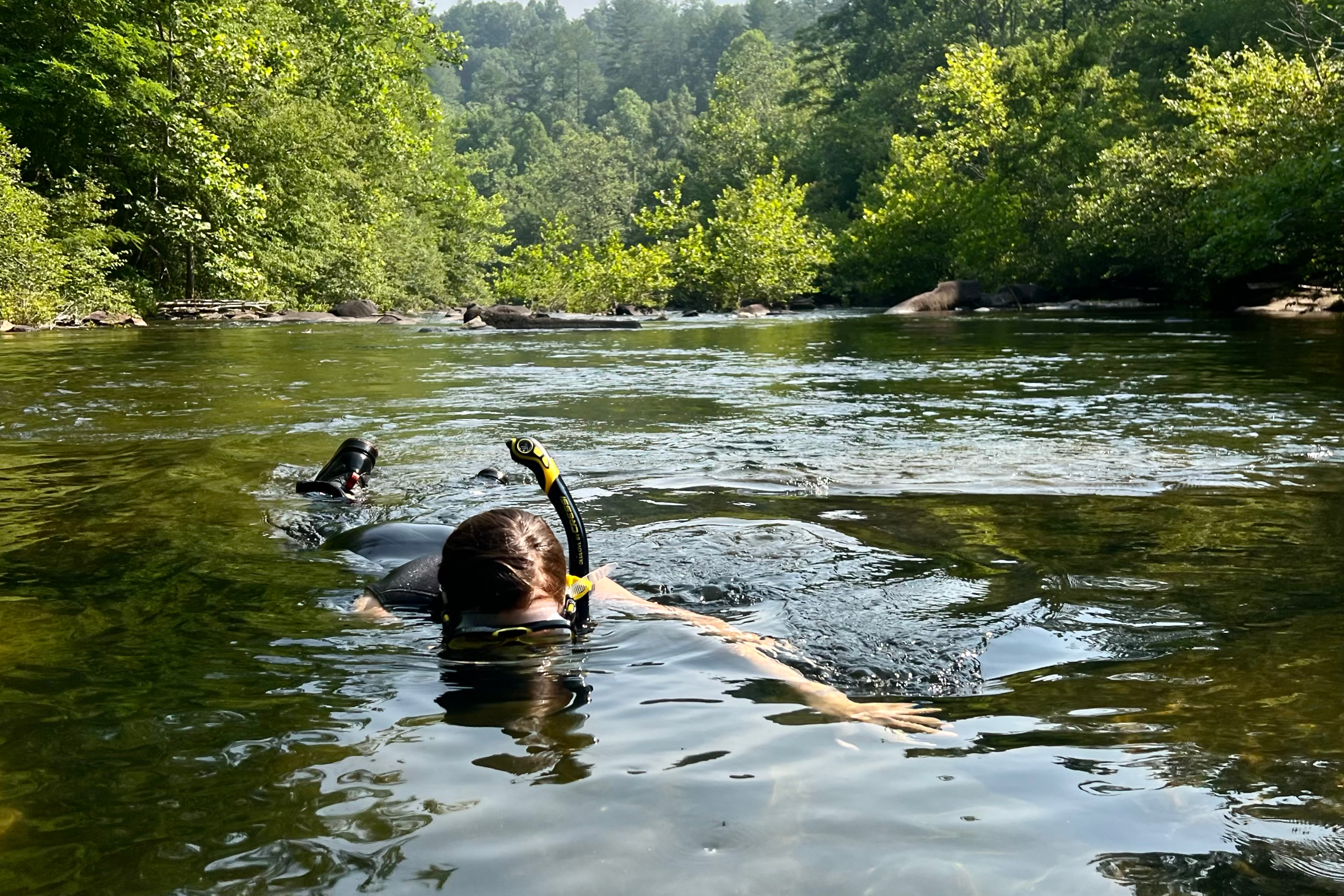Travel
Why Freshwater Snorkeling Should Be Your Next Adventure
The rivers of Western North Carolina harbor a colorful secret world. See it for yourself on the new Blue Ridge Snorkel Trail

Photo: Ally Sloway
The author in the Cheoah River in Nantahala National Forest.
It may look a touch absurd, donning snorkel gear to lie on one’s stomach in a shallow river, face submerged, head swiveling back and forth, watching creatures invisible to terrestrial passersby. But absurdity is a small price to pay for the world a river snorkeler becomes privy to: the red flash of saffron shiners, the traffic-cone orange of tangerine darters, the perfect camouflage of mottled sculpin, and the pinkish tint of half-submerged rainbow mussels.
Last month, the Blue Ridge Snorkel Trail opened—an unofficial, do-it-yourself collection of ten sites over ten counties and nine rivers in Western North Carolina, each marked with a sign detailing ten standout species you might see if you bring a mask along. “These are places people are coming to swim and float anyway,” North Carolina Wildlife Resources Commission aquatic biologist Luke Etchison points out. He co-created the trail in the hopes of encouraging more people to put their heads underwater. “I just want them to see what we see everyday. It’s like a scavenger hunt, with every river holding something different.”
I meet Etchison and fellow biologist Chantelle Rondel at the first of four sites we’ll visit together, on the Mills River outside of Asheville. My first attempt goes like this: I tug on a wetsuit I panic-borrowed from my boss at the last minute, put on my mask, dip under the surprisingly cold water—all two feet of it—and am pulled by a current I did not expect. I fumble at tendrils of riverweed to try and stop myself but soon give up and allow myself to float, suspended over the bustling world of pebbles and fish and crayfish and mussels. Then I hit a log, snort water, and sit back up into the cheerful North Carolina sunshine.
My snorkeling guides are having no such trouble—Etchison and Rondel have glided into the water like fish themselves and weave elegantly up the riverbed, periodically identifying the things they see—a banded darter, a stoneroller, a French Broad crayfish, a freshwater lamprey. A slippershell mussel, hidden among the stones.

Photo: LUKE ETCHISON
A pair of tangerine darters.
By the second site, on the Pigeon River a half hour from Asheville, I’ve gotten better, probably because I started following Etchison’s advice to army crawl rather than flail. Here, we watch river chubs, habitat engineers that select and carry pebbles in their mouths to build large mounds for spawning. Tangerine darters weave among the rocks, unbothered by our presence. “You can see how the fish just move around you, like you’re part of the habitat,” Etchison says, poking his head up. Occasionally I mumble a question at him through my mask, but mostly we snorkel silently, in our own orbits of fascination.
Though I love the foot-long northern hogsuckers and the Tuckasegee stream crayfish on the Tuckasegee River, the Cheoah River site is my favorite. It’s tucked in the Nantahala National Forest as far west as North Carolina stretches, framed by trees and without a soul in the vicinity. The water is warm compared with the other sites—no wetsuit needed, though I put one on anyway because I don’t trust Etchison when he tells me not to, as he seems immune to cold water. Spotfin chub are the stars of the show here: They’re a metallic blue that catches the light, and they seem actively curious about these invaders of their world, approaching to investigate my fingertips. I’ve got the hang of snorkeling by now, and it’s a pure delight to crawl slowly up the river, noticing each tiny creature, and then let the current sweep you back downstream, feeling as if you’ve joined the ranks of aquatic life.
Farther up the Cheoah, Rondel points out a wavy-rayed lampmussel with its lure out, poised to spread its offspring in the river. The larvae of mussels hitch rides on fish gills to find their own patch of river bottom—but to catch that ride, the parent mussel must first attract a fish by putting out a lure that looks crazily, impossibly like a food source; sometimes a red worm, sometimes a small fish.
Life this specialized is ancient and fragile. The web of species in these waters evolved over millions and millions of years; some are found only in a single stretch of river, and some have not even been described to science. Much of what we see is imperiled, either federally listed like the Appalachian elktoe mussel or state-listed like the olive darter. At the heart of Etchison’s mission to bring people underwater is to raise awareness for conservation. “I want to reconnect people to these rivers,” he says. “If people knew what was here, they would care about it and want to protect it.”

Photo: Luke Etchison
A wavy-rayed lampmussel and its lure.

Photo: Ally Sloway
Admiring a Tuckasegee Stream crayfish.
He, Rondel, and their colleague Dylan Owensby work full time to do just that, with a mind-boggling schedule of projects. To name a few: They propagate mussels and stock them in the Cheoah River, where the bivalves had completely disappeared due to years of habitat degradation. Twice a year they catch tangerine darters from the Pigeon River and reintroduce them into the French Broad, Swannanoa, and Mills rivers, where the species was historically found. They monitor and reintroduce sicklefin redhorses in the Little Tennessee River watershed. And there’s something Etchison calls the French Broad Revival, where the team is working to restore a whole suite of species that disappeared from that waterway due to degradation and damming, including smallmouth buffalo, freshwater drum, gizzard shad, and rainbow mussels.
Etchison chose this collection of ten sites for the Blue Ridge Snorkel Trail because the water is usually clear, there’s typically lots of fish, and there’s some knockout species at each—an easy sell for first-timers. On the Pigeon River, we pass a father-daughter pair floating by in tubes just as Etchison catches something in the net he’s brought along. “I thought y’all were looking for jewelry or something,” the man says as he and his daughter peer inside the net at the orange scales and dramatic splash of black of a tangerine darter. “I guess you could say that,” Etchison replies before he lets the fish swim away and it disappears back into the rocky waterbed. “These fish are the jewels of Appalachia.”
Ten Sites on the Blue Ridge Snorkel Trail
Find more information here.
Tips for River Snorkeling
1. Bring a wetsuit if you plan to spend a long time snorkeling. If you’re just dipping in and out in the summer months, none needed. Water temperatures range from the upper 60s to the upper 70s from May to September.
2. Go upstream, army crawling, before letting yourself float back to your starting point. Use your arms to guide and pull yourself.
3. Look behind you occasionally—fish will gather around your feet.
4. Bring along baby shampoo to clear your mask. Squirt a little in, then wash it gently in the river.
5. If you don’t have a mask and snorkel, even goggles will do, especially for kids.
6. For a guided experience, Niki Aquatics and Oxbow River Snorkeling offer snorkeling trips.
7. Leave the stream as you found it.

Photo: Ally Sloway
Watching spotfin chub in the Cheoah River.







